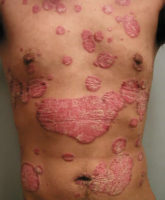Psoriasis
Definition
Psoriasis is a chronic life-long autoimmune condition that causes itchy, dry and red skin. Psoriasis causes skin cells to multiply faster than normal.
Psoriasis is also associated with an increased risk for depression, heart disease and diabetes, among other conditions.
Epidemiology
Psoriasis affects about 3 percent of the world’s population.
It is estimated to affect at least 125 million around the world in 2016.
The American Academy of Dermatology estimates psoriasis affects about 7.5 million Americans.
Symptoms
Skin cells cause raised, red patches covered by silvery scales when they reach the surface of the skin and die.
It occurs most commonly on the scalp, knees, elbows, hands, and feet, but can also appear on the lower back, face, genitals, nails, and other places.

Credit picture: PENN MEDICINE
Risks
Type 2 diabetes and psoriasis
People with psoriasis are at a higher risk to develop type 2 diabetes than those without psoriasis, and the risk increases dramatically based on the severity of the disease. Researchers from the Perelman School of Medicine at the University of Pennsylvania found people with psoriasis that covers 10 percent of their body or more are 64 percent more likely to develop diabetes than those without psoriasis, independent of traditional risk factors such as body weight.
Treatments
There is no cure for psoriasis.
But there are several treatments for psoriasis
– Ixekizumab
About 80 percent of patients with moderate to severe psoriasis saw their disease completely or almost completely cleared with a new drug called ixekizumab, according to three large, long-term clinical trials led by Northwestern Medicine. The results of these phase III trials were compiled in a paper published in the New England Journal of Medicine in 2016.
Ixekizumab works by neutralizing a pathway in the immune system known to promote psoriasis.
Sources:
New England Journal of Medicine, Perelman School of Medicine at the University of Pennsylvania
Pictures: Penn Medicine, Fotolia.com
